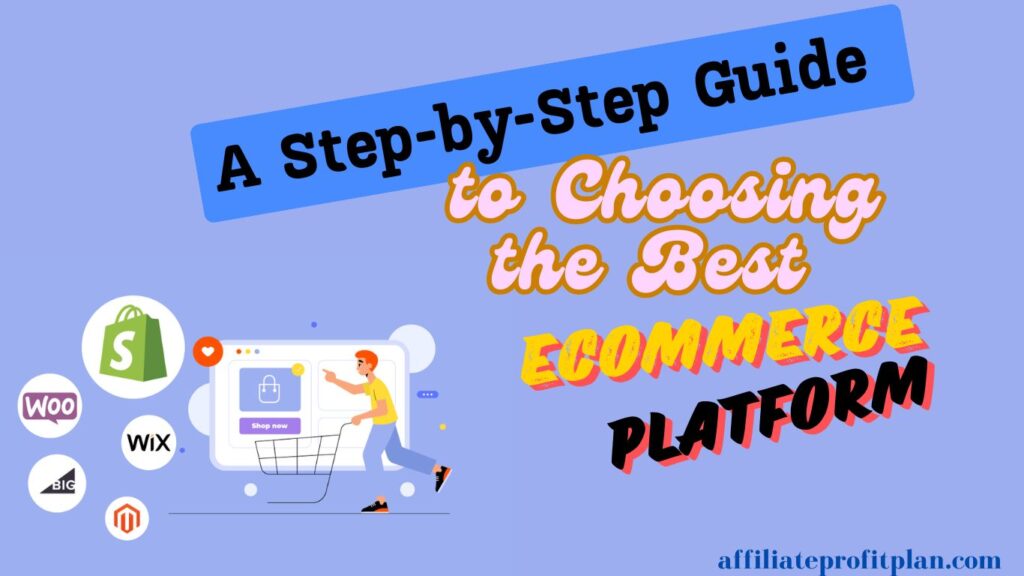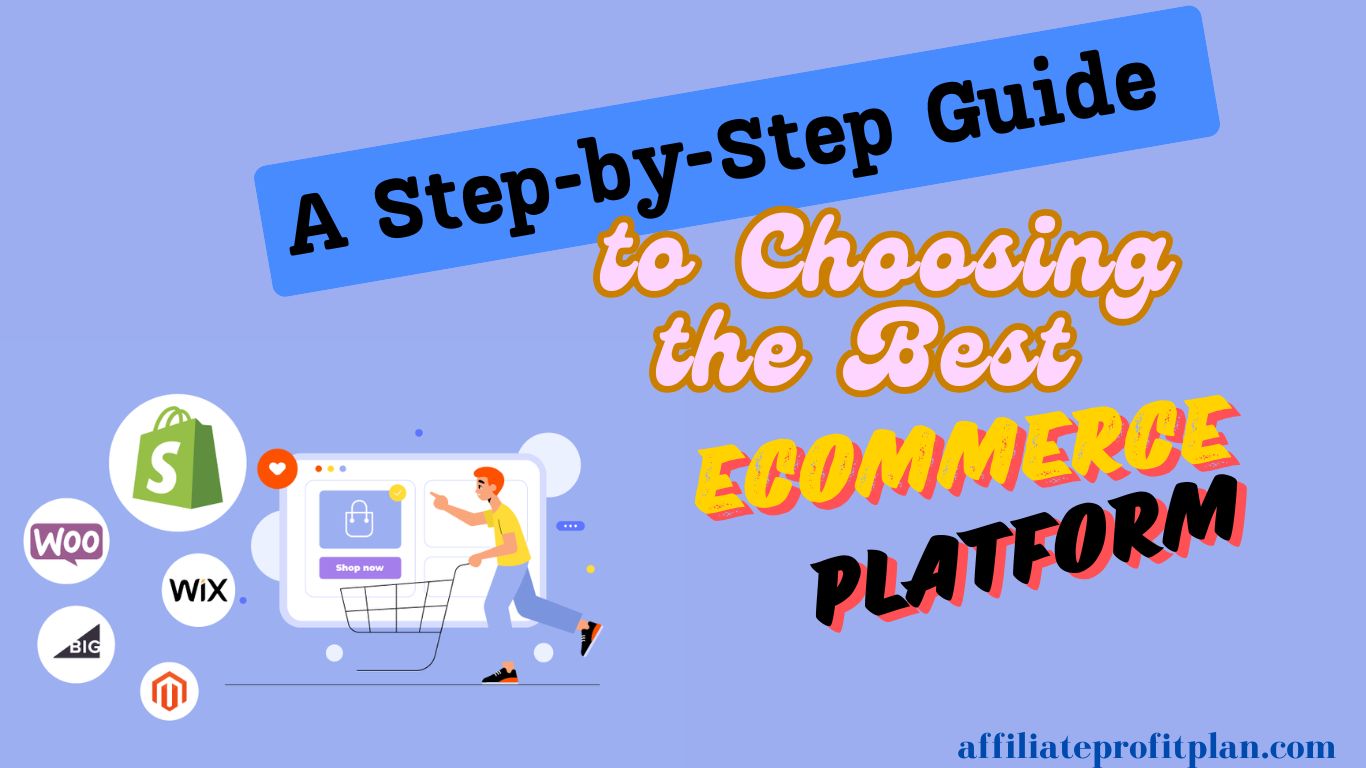Welcome to my article A Step-by-Step Guide to Choosing the Best eCommerce Platform. So, you’ve decided to launch an online store—awesome! But before you start dreaming of six-figure sales and laptop-lifestyle vacations, there’s one crucial decision you need to make: choosing the right eCommerce platform. And trust me, this is not the step you want to wing. Picking the wrong platform is like buying a sports car when you really needed an SUV—sure, it looks cool, but you’ll be struggling with every speed bump (or in this case, every product listing, checkout error, and missing feature).
But don’t worry! In this step-by-step guide, we’ll break down exactly how to choose the best eCommerce platform for your business—without getting lost in a sea of jargon, unnecessary features, or budget-breaking surprises. By the end, you’ll have a clear roadmap to picking the perfect platform that fits your business needs like a glove. Let’s get started!
Access My Proven Blueprint for $50-$100 Daily Income – Watch This FREE Video Now >>>

Identify Your Business Needs and Goals: Because One Size Does Not Fit All
Before diving headfirst into the world of eCommerce platforms, pump the brakes for a second. The biggest mistake new entrepreneurs make? Choosing a platform before figuring out what they actually need. It’s like buying a fancy espresso machine when all you drink is instant coffee—overkill, expensive, and completely unnecessary.
Your ideal platform depends on what kind of store you want to run, who your customers are, and how big you plan to grow. Ask yourself these key questions before making a decision:
What Are You Selling?
Not all eCommerce platforms are built the same. Some are great for physical products, while others are better for digital goods, subscriptions, or even services.
- Selling physical products? You’ll need inventory management, shipping integrations, and a seamless checkout process.
- Selling digital products (eBooks, courses, printables)? Look for instant download capabilities and zero shipping headaches.
- Running a subscription box or membership site? Make sure the platform supports recurring billing.
- Offering services? Your platform should handle appointment scheduling or invoicing easily.
Where Are You Selling?
Are you only selling through your website, or do you want to expand to Amazon, eBay, Etsy, or social media? If multi-channel selling is in your plans, choose a platform that seamlessly integrates with other marketplaces. Some platforms make selling on Instagram super easy, while others require complicated (and often pricey) third-party apps.
How Much Control Do You Need Over Design & Customization?
- If you want a drag-and-drop, no-tech-skills-required solution, platforms like Shopify or Wix are your best bet.
- If you need full control and custom coding, open-source options like WooCommerce or Magento offer endless flexibility.
- If you’re somewhere in between, platforms like BigCommerce or Squarespace balance ease of use with customization options.
How Fast Do You Plan to Grow?
You may be starting small, but what happens when your store blows up and you’re processing thousands of orders a month? (Hey, let’s manifest that!) Your platform should be able to handle increased traffic, more products, and advanced features as you scale.
- Small, boutique-style store? A simple platform like Wix or Shopify Starter may work.
- Planning to expand quickly? Look for scalable options like Shopify, BigCommerce, or WooCommerce.
- Going full enterprise? Magento or custom-built solutions might be the best route.
Final Thought: The Right Platform Starts with the Right Plan
Choosing an eCommerce platform isn’t just about cool features and pricing—it’s about picking something that actually supports your business model, goals, and future growth. Before you commit, take the time to identify your needs, understand your audience, and think long-term.
Because trust me—switching platforms down the line is about as fun as moving to a new house with no boxes, no truck, and no idea where anything goes.
Compare Features & Functionality: Don’t Settle for a Bare-Bones Store
Alright, so you’ve nailed down your business goals. Now comes the fun (and slightly overwhelming) part—comparing eCommerce platforms based on features. Think of this like buying a car: Do you need a simple, reliable ride, or are you looking for a feature-packed sports car with all the bells and whistles?
Some platforms offer a sleek, plug-and-play experience, while others require a bit of technical know-how but give you complete control. Your goal? Find the perfect balance of features without overpaying for stuff you’ll never use. (Looking at you, AI-powered, VR-integrated, blockchain-driven shopping carts. 🙄)
Ease of Use: Can You Set It Up Without Crying?
If you’re not a developer and don’t plan on hiring one, you need a platform that’s easy to use and doesn’t require coding skills. Look for:
✅ Drag-and-drop website builders (like Shopify and Wix)
✅ Pre-designed templates that look professional out of the box
✅ User-friendly dashboard for managing orders, inventory, and customers
🚀 Best for beginners: Shopify, Wix, BigCommerce
👨💻 Best for advanced users: WooCommerce, Magento
Customization: Can You Make It Look Exactly How You Want?
Some platforms give you full creative control, while others keep things simple with pre-built themes. The more customization you need, the more flexibility (and potentially coding skills) you’ll require.
🎨 Limited customization but easy to use: Shopify, Squarespace
🔧 Highly customizable but requires more effort: WooCommerce, Magento
SEO & Marketing Tools: Will Your Store Actually Get Traffic?
Building a store is one thing—getting people to find it is a whole different game. The best eCommerce platforms come with SEO and marketing tools to help you attract customers and grow your sales.
🛠 Must-have marketing features:
✅ SEO-friendly URLs & metadata (Google needs to love your store!)
✅ Email marketing integrations (because follow-up emails = $$$)
✅ Discount & promo code capabilities (who doesn’t love a good sale?)
✅ Abandoned cart recovery (because customers forget to check out—A LOT)
✅ Social media & marketplace integrations (sell on Instagram, Facebook, or even Amazon)
🚀 Best for marketing tools: Shopify, BigCommerce
⚡ Best for SEO control: WooCommerce, Magento
Mobile Responsiveness: Because Everyone Shops on Their Phones
Fact: More than 60% of online shopping happens on mobile devices. If your store isn’t mobile-friendly, you’re leaving money on the table.
The good news? Most modern eCommerce platforms offer mobile-responsive themes. But some go a step further with mobile-optimized checkout experiences, fast-loading pages, and app integrations.
📱 Best for mobile-first experience: Shopify, Squarespace
🛠 More control over mobile design: WooCommerce, Magento
Multi-Channel Selling: Can You Sell Everywhere?
Want to sell on Instagram, Facebook, Etsy, Amazon, or even TikTok? Some eCommerce platforms make this seamless, while others require third-party apps and extra work.
🌎 Best for multi-channel selling:
✅ Shopify (built-in integrations with social platforms)
✅ BigCommerce (great for marketplaces like Amazon & eBay)
Final Thought: Choose Wisely, or Regret Later
The right eCommerce platform should match your skill level, offer the features you actually need, and set you up for growth. Don’t fall for fancy features you’ll never use—focus on what will help you sell more, market better, and scale faster.
Because the last thing you want is to realize you picked the wrong platform after you’ve already added 500 products.
Evaluate Pricing & Scalability: Don’t Let Hidden Fees Eat Your Profits
Let’s be real—budget matters. You don’t want to spend all your money on an eCommerce platform before you even make your first sale. The trick is finding a platform that fits your budget now while also scaling with your business as it grows (because let’s manifest those six-figure sales 💰).
Access My Proven Blueprint for $50-$100 Daily Income – Watch This FREE Video Now >>>
But beware—some platforms look cheap upfront, only to surprise you with hidden fees, expensive add-ons, and transaction charges (like a “free” app that suddenly charges $10/month for every feature you actually need 🙄). Let’s break it down.
The Real Cost of eCommerce Platforms
Most eCommerce platforms use one of these three pricing models:
💳 Subscription-Based (Monthly Fees)
- Shopify, BigCommerce, Wix, and Squarespace fall into this category.
- Prices range from $29/month to $299+/month depending on features.
- Usually includes hosting, security, and basic features.
💰 Self-Hosted (Pay-As-You-Go)
- WooCommerce and Magento are free to install but come with extra costs.
- You’ll need to pay for hosting, themes, plugins, security, and maintenance.
- Can be cheaper or more expensive, depending on what you add.
⚠️ Hidden Costs to Watch Out For:
✅ Transaction fees – Some platforms take a cut of every sale (Shopify charges extra unless you use Shopify Payments).
✅ Payment gateway fees – PayPal, Stripe, and credit card processors all take a percentage.
✅ Premium themes & plugins – Want a fancy storefront? That might cost extra.
✅ Hosting & maintenance – WooCommerce and Magento require your own hosting, which adds to costs.
Will This Platform Scale with You?
What works for a small store today might not handle thousands of orders tomorrow. Before committing, ask:
🚀 Can it handle more traffic?
- Some platforms (like Shopify and BigCommerce) auto-scale, while others (like WooCommerce) need manual server upgrades.
📦 Does it support large inventories?
- If you’re selling hundreds or thousands of products, make sure your platform won’t slow down (or charge extra for more SKUs).
🛒 Are there affordable upgrades?
- Some platforms double or triple their pricing as you grow. Check upgrade costs!
📈 Will it support international sales?
- Planning to sell globally? You’ll need multi-currency, multi-language, and international shipping support.
Best Platforms Based on Budget & Growth Plans
💸 For small businesses & startups: Wix, Shopify Basic, WooCommerce (low-cost, easy to start)
💰 For mid-sized businesses: Shopify Standard, BigCommerce (more features, solid growth potential)
💼 For large businesses: Shopify Plus, Magento, WooCommerce on dedicated hosting (handles high traffic, advanced features)
Final Thought: Plan for Growth, Not Just Today
Picking the cheapest platform might cost you more in the long run if it can’t grow with you. Look for a balance between affordability and scalability, so you’re not forced to switch platforms once your business takes off (trust me, migrating an entire store is a nightmare you don’t want 😅).
Because the goal isn’t just to start small—it’s to scale big without breaking the bank.
Check Payment & Security Options: Because No One Likes a Shady Checkout
You’ve spent hours designing a killer online store, optimized your product pages, and even mastered the art of writing persuasive product descriptions (go you!). But if your payment system is clunky or doesn’t feel secure, guess what? Customers will abandon their carts faster than you can say “credit card declined.”
Choosing the right payment gateways and security measures isn’t just about convenience—it’s about building trust, preventing fraud, and making sure you actually get paid. Let’s break it down.
Payment Gateways: Give Your Customers Options
Think of payment gateways as the digital cash registers of your store. The more options you offer, the more customers you can accommodate. Because let’s be honest—not everyone wants to type in their credit card number when Apple Pay is right there.
✅ Popular Payment Gateways:
- PayPal – Everyone knows it, most people trust it.
- Stripe – Developer-friendly and works great for global payments.
- Shopify Payments – Shopify’s built-in option (bonus: avoids extra transaction fees).
- Square – Great for businesses with both online and in-person sales.
- Apple Pay & Google Pay – Essential for mobile-friendly checkouts.
- Buy Now, Pay Later (BNPL) – Services like Klarna and Afterpay boost conversions by letting customers split payments.
📌 Pro Tip: Avoid platforms that force you to use only one payment gateway (cough Shopify and its “extra fees” for using third-party options). Flexibility is key!
Transaction Fees: Because Every Dollar Counts
Most payment gateways charge processing fees, but some eCommerce platforms add extra transaction fees on top of that (ugh, why?).
🔍 What to check:
- Credit card processing fees (usually 2.9% + $0.30 per transaction).
- Extra platform fees (Shopify charges up to 2% per sale if you don’t use Shopify Payments).
- International fees (selling globally? Some gateways add currency conversion charges).
💡 Solution: Compare total costs before choosing a platform, and look for ways to minimize fees (like using the platform’s preferred gateway).
Security: Keep Hackers (and Chargebacks) Away
If customers don’t feel safe entering their payment details, they won’t buy. And if hackers find a way into your store, you’re looking at financial losses, legal troubles, and a major hit to your reputation. (Not fun.)
🛡️ Must-Have Security Features:
✅ SSL Certificate – Encrypts customer data (your URL should always start with “https”).
✅ PCI Compliance – Ensures your store follows credit card security standards.
✅ Fraud Protection Tools – Detects suspicious transactions and prevents chargebacks.
✅ Two-Factor Authentication (2FA) – Extra security for your admin dashboard.
📌 Pro Tip: Never store customer payment info on your site. Let secure payment gateways handle that—it’s safer and keeps you out of legal trouble.
Checkout Experience: Make It Smooth & Fast
A complicated checkout process is one of the top reasons for abandoned carts. Here’s how to keep customers from bailing at the last second:
🛒 Frictionless checkout tips:
✅ Offer guest checkout – Not everyone wants to make an account.
✅ Use auto-fill & saved payment options – The fewer steps, the better.
✅ Make it mobile-friendly – Over 60% of online purchases happen on a phone.
✅ Display trust badges – Show logos for SSL, PayPal, Visa, etc., to boost confidence.
💡 Bonus: Consider one-click checkout options like Shop Pay or Amazon Pay to speed things up.
Final Thought: Easy, Secure, and Cost-Effective Wins the Race
Your payment and security setup can make or break your eCommerce business. The goal? Give customers multiple, trusted ways to pay, keep their data safe, and minimize fees wherever possible.
Because the last thing you want is a customer ready to buy—only for them to leave because their favorite payment method wasn’t available.
Review Customer Support & User Reviews: Because Tech Issues Don’t Wait for Business Hours
Imagine this: It’s Black Friday, your store is flooded with visitors (yay!), and suddenly—BOOM—your checkout page stops working (not yay!). You frantically reach out to your eCommerce platform’s support team, only to be met with… a chatbot that tells you to “check the FAQ section.”
Yeah, good customer support matters—a LOT. The last thing you want is to be stuck Googling solutions at 2 AM when your store is down and every second is costing you sales. Before committing to a platform, let’s talk about why customer support and user reviews should be non-negotiable.
Customer Support: Will They Actually Help You When It Matters?
Some eCommerce platforms offer 24/7 live support, while others act like answering an email within 3 business days is acceptable. (It’s not.) When choosing a platform, check:
✅ Support Availability – Is it 24/7, or only during business hours?
✅ Support Channels – Do they offer live chat, phone support, email, and community forums?
✅ Response Time – Are they actually helpful, or will you be stuck waiting hours (or days) for a reply?
🚀 Best for customer support:
- Shopify – 24/7 live chat, phone, and email support (quick responses, friendly reps).
- BigCommerce – 24/7 live support (solid but not always as fast as Shopify).
- WooCommerce & Magento – No dedicated support, but huge user communities for troubleshooting.
📌 Pro Tip: Test customer support before you commit—reach out with a question and see how fast/helpful their response is!
User Reviews: What Are Real Store Owners Saying?
Let’s be honest—every platform claims to be the best. But the real truth? It’s in the user reviews.
🔍 Where to find honest feedback:
- Trustpilot & G2 – Real user reviews (watch out for fake “sponsored” ones).
- Reddit & Facebook Groups – Actual business owners spill the tea on what works and what doesn’t.
- YouTube Reviews – Many store owners share detailed walkthroughs and pros/cons.
🚩 Red Flags in User Reviews:
❌ Frequent downtime & crashes – If multiple users complain, that’s a major warning sign.
❌ Poor customer support experiences – If people say they can’t get help when they need it, run.
❌ Hidden fees – Some platforms charge extra for features you thought were included (check the fine print!).
💡 Bonus Tip: Pay attention to recent reviews—platforms change, and what was great two years ago might be a nightmare now.
Community & Third-Party Resources: The Backup Plan
Even if customer support is great, having access to community forums, third-party resources, and expert developers can be a lifesaver.
💬 Platforms with the Best Community Support:
- WooCommerce & Magento – Massive developer communities, tons of plugins and guides.
- Shopify – Active forums, plus Shopify Experts for hire.
- BigCommerce – Helpful community, but smaller than WooCommerce or Shopify.
Having a strong user community means that if you ever hit a technical roadblock, you’re not alone—someone else has probably been there and found a fix.
Final Thought: A Great Platform Without Support is Useless
Your eCommerce platform isn’t just a one-time setup—it’s your business’s foundation. Whether it’s a technical glitch, an unexpected spike in traffic, or just a random setting you can’t figure out, you need reliable support and real user insights.
Because trust me, the last thing you want is to be stuck refreshing a “help center” page while your customers are getting error messages.
Conclusion: Making the Right Choice Without Losing Your Sanity
By now, you’ve probably realized that choosing an eCommerce platform isn’t as simple as flipping a coin (though that would be nice, right?). It’s a big decision—one that affects your store’s success, your customer experience, and even your own stress levels (because nobody wants to deal with constant tech headaches).
Access My Proven Blueprint for $50-$100 Daily Income – Watch This FREE Video Now >>>
So, let’s do a quick recap of what you need to keep in mind:
✅ Identify Your Business Needs & Goals – Are you running a small side hustle or aiming to build the next Amazon?
✅ Compare Features & Functionality – Does the platform support what you need, or will you be duct-taping plugins together?
✅ Evaluate Pricing & Scalability – Cheap today doesn’t always mean cost-effective in the long run.
✅ Check Payment & Security Options – No shady checkout experiences, please.
✅ Review Customer Support & User Reviews – Because when things go wrong (and they will), you need real help, not a chatbot sending you to an FAQ page.
So, What’s the “Best” eCommerce Platform?
Honestly, there’s no one-size-fits-all answer. The “best” platform is the one that fits your business, your budget, and your long-term goals.
- Newbie-friendly & all-in-one? → Shopify.
- More control & customization? → WooCommerce or Magento.
- Scalable & powerful for growth? → BigCommerce.
- Drag-and-drop simplicity? → Wix or Squarespace.
Final Thought: Choose Wisely, But Don’t Overthink It
Yes, this is an important decision—but don’t let analysis paralysis stop you from getting started. Many successful stores switched platforms down the road, and you can too if needed. The key is to pick the best option for where you are today and start selling.
Because at the end of the day, the perfect eCommerce platform won’t build your business for you—but making the right choice will set you up for success.
Thanks a lot for reading my article on “A Step-by-Step Guide to Choosing the Best eCommerce Platform” till the end. Hope you’ve helped. See you with another article.










